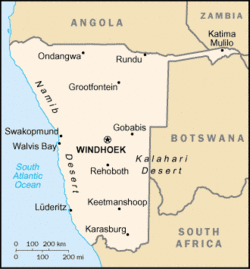Welcome to the Virtual Education Wiki ~ Open Education Wiki
Namibia: Difference between revisions
(added general material and cat Commonwealth; and education) |
(added cat SADC) |
||
| Line 100: | Line 100: | ||
[[Category:Africa]] | [[Category:Africa]] | ||
[[Category:Southern Africa]] | [[Category:Southern Africa]] | ||
[[Category:Southern African Development Community]] | |||
[[Category:Commonwealth countries]] | [[Category:Commonwealth countries]] | ||
[[Category:German-speaking countries]] | [[Category:German-speaking countries]] | ||
[[Category:Countries of interest]] | [[Category:Countries of interest]] | ||
Revision as of 10:26, 29 January 2010
Partners situated in Namibia
None.
Namibia in a nutshell
Namibia, officially the Republic of Namibia (Afrikaans: Republiek van Namibië, German: Republik Namibia), is a country in Southern Africa whose western border is the Atlantic Ocean. It shares land borders with Angola and Zambia to the north, Botswana and Zimbabwe to the east, and South Africa to the south and east.
It has been given many names: the land of contrasts, the land God made in anger, the ageless land. For many years it was known only as South West Africa, but it adopted the name Namibia, after the Namib Desert.
It gained independence from South Africa in 1990.
Its population is just over 2 million. It is the second least densely populated country in the world, after Mongolia.
Its capital and largest city is Windhoek (German: Windhuk).
Namibia is a member state of the United Nations (UN), the Southern African Development Community (SADC), the African Union (AU), the Commonwealth of Nations and many other international organisations.
The official language is English. Until 1990, German and Afrikaans were also official languages. Long before Namibia's independence from South Africa, it had been decided that the country would become officially monolingual, consciously choosing this approach in contrast to that of its neighbour. Therefore, English became the sole official language of Namibia. Afrikaans, German, and Oshiwambo became recognised regional languages.

Namibia education policy
Namibia has compulsory free education for 10 years between the ages of 6 and 16 with 7 years of Primary education and 5 years of secondary education.
Namibia education system
In 1998, there were 400,325 Namibian students in primary school, about 80% of those eligible, and 115,237 students in secondary schools, about 34% of those eligible. The pupil-teacher ratio in 1999 was estimated at 32:1, with about 8% of the GDP being spent on education.[42]
Most schools in Namibia are state-run, however, there are a few private and semi-private schools that serve the country's education system. Among these are St. Pauls College, Windhoek Afrikaanse Privaatskool, Deutsche Höhere Privat Schule and Windhoek Gymnasium. Click here for an incomplete list of schools in Namibia.
Namibia' Ministry of Education is, in part, supported by the National Institute for Educational Development (NIED) in Okahandja. NIED is responsible for the Nation's curriculum development, educational research, and professional development of teachers.
Higher education
There are four Teacher Training Colleges, three Colleges of Agriculture, a Police Training College, a Polytechnic at university standard, and a National University.
Universities in Namibia
There seems to be just one university in Namibia, the University of Namibia (http://www.unam.na). This has a Centre for External Studies, which ensures that quality higher educations is accessible to the nation through the provision of distance and open learning programmes. CES collaborates with faculties and other University Centres to offer formal programmes leading to degrees, diplomas and certificates as well as non-formal programmes. It operates through three departments of: Materials Development and Instructional Design; Student Support; and the Department of Continuing Education.
- "The Centre offers the following formal qualifications: Bachelor of Nursing Science Degree (Advanced Practice), Bachelor of Accounting, Bachelor of Business Administration, Bachelor of Education, Specialised Diploma in Education (Home Economics or Fashion and Fabrics), Specialised Diploma in Educational Management and Leadership, Diploma in Adult Education and Community Development, Diploma in HIV/AIDS Counselling and Management, Postgraduate Diploma in Education, Certificate in Accounting and Auditing, Certificate in HIV/AIDS Counselling, Certificate in Mid-level Management and Certificate in Taxation and Management."
CES is also responsible for the management of eight University Regional Centres and manages a large office at the Northern Campus in Oshakati. Regional activities and services are supported by regional administrative and student support officers.
Polytechnics in Namibia
There is one university-standard polytechnic.